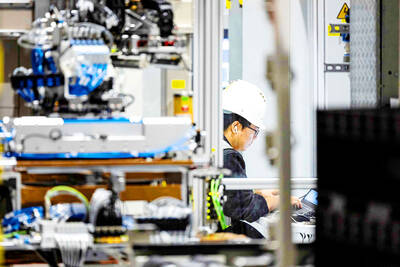Share prices close lower
Taiwanese share prices closed 1.24 percent lower yesterday as dealers took further profits following a lengthy rally last week, dealers said.
The TAIEX index fell 92.27 points to 7,376.76 on turnover of NT$127.65 billion (US$3.95 billion).
Losers outnumbered gainers 2,041 to 528, while 135 shares remained unchanged. A total of 24 stocks fell to their daily 7.0 percent limit, against nine limit-up.
“It’s time for the market to take a breather after such a big rally,” said David Li (李衍磐), sales trader at Daiwa Securities SMBC-Cathay Co (大和國泰).
Taiwanese stocks have fallen for the past three days after rising 2.58 percent last week.
Government plans bonds sale
The government is planning to sell NT$140 billion (US$4.3 billion) in bonds in the fourth quarter to help fund spending, NT$40 billion more than was sold in the final three months of last year.
Taiwan will auction NT$30 billion in five-year notes on Oct. 5, NT$40 billion in two-year securities on Oct. 16, NT$30 billion of 20-year debt on Nov. 17, and NT$40 billion in 10-year bonds on Dec. 11, a statement posted on the Ministry of Finance’s Web site said yesterday.
The government will also sell NT$125 billion of Treasury bills in the period.
Remittances increase gradually
Remittances to Taiwan from Taiwanese listed and over-the-counter (OTC) companies that have business operations in China have increased gradually over the last four years, the Financial Supervisory Commission (FSC) reported on Tuesday.
As of the end of June, 928 Taiwanese listed and OTC companies had invested in China, representing 72.5 percent of all listed and OTC companies in Taiwan, with their combined investments totaling NT$899.6 billion (US$27.68 billion), FSC tallies showed.
In the second quarter of this year, the 928 firms had remitted NT$81.3 billion of their profits, marking a 9.04 percent ratio of their combined investments.
This was higher than the ratio of 8.56 percent posted in the previous quarter and 8.51 percent recorded in the last quarter of last year, the FSC tallies show.
Electronics and computer companies, which comprise the bulk of Taiwanese companies operating in China, were the biggest remitters, the FSC said.
Taiwan set to buy US produce
Taiwan is set to purchase US$3.5 billion worth of farm products from the US, officials at Taiwan’s representative office in Washington said.
A Taiwanese procurement mission, led by former minister of the Council of Agriculture Sun Ming-hsien (孫明賢), were to meet with US congressmen and visit relevant federal agencies before signing a letter of intent yesterday to buy agricultural goods in the next two years.
This is the seventh such Taiwanese mission to the US since 1998.
Beginning today, the delegation will split up into two groups, with one focusing on the procurement of soy beans and the other on sweet corn and wheat.
The first group will visit the states of Indiana, Illinois, Iowa and Missouri, while the second will go to Kansas, North Dakota, Montana and California to appraise the crops they are interested in buying.
NT dollar ends day higher
The New Taiwan dollar gained ground against the US dollar on the Taipei Foreign Exchange yesterday, rising NT$0.017 to close at NT$32.369.
Turnover was US$748 million.

CHIP RACE: Three years of overbroad export controls drove foreign competitors to pursue their own AI chips, and ‘cost US taxpayers billions of dollars,’ Nvidia said China has figured out the US strategy for allowing it to buy Nvidia Corp’s H200s and is rejecting the artificial intelligence (AI) chip in favor of domestically developed semiconductors, White House AI adviser David Sacks said, citing news reports. US President Donald Trump on Monday said that he would allow shipments of Nvidia’s H200 chips to China, part of an administration effort backed by Sacks to challenge Chinese tech champions such as Huawei Technologies Co (華為) by bringing US competition to their home market. On Friday, Sacks signaled that he was uncertain about whether that approach would work. “They’re rejecting our chips,” Sacks

NATIONAL SECURITY: Intel’s testing of ACM tools despite US government control ‘highlights egregious gaps in US technology protection policies,’ a former official said Chipmaker Intel Corp has tested chipmaking tools this year from a toolmaker with deep roots in China and two overseas units that were targeted by US sanctions, according to two sources with direct knowledge of the matter. Intel, which fended off calls for its CEO’s resignation from US President Donald Trump in August over his alleged ties to China, got the tools from ACM Research Inc, a Fremont, California-based producer of chipmaking equipment. Two of ACM’s units, based in Shanghai and South Korea, were among a number of firms barred last year from receiving US technology over claims they have

It is challenging to build infrastructure in much of Europe. Constrained budgets and polarized politics tend to undermine long-term projects, forcing officials to react to emergencies rather than plan for the future. Not in Austria. Today, the country is to officially open its Koralmbahn tunnel, the 5.9 billion euro (US$6.9 billion) centerpiece of a groundbreaking new railway that will eventually run from Poland’s Baltic coast to the Adriatic Sea, transforming travel within Austria and positioning the Alpine nation at the forefront of logistics in Europe. “It is Austria’s biggest socio-economic experiment in over a century,” said Eric Kirschner, an economist at Graz-based Joanneum

France is developing domestic production of electric vehicle (EV) batteries with an eye on industrial independence, but Asian experts are proving key in launching operations. In the Verkor factory outside the northern city of Dunkirk, which was inaugurated on Thursday, foreign specialists, notably from South Korea and Malaysia, are training the local staff. Verkor is the third battery gigafactory to open in northern France in a region that has become known as “Battery Valley.” At the Automotive Energy Supply Corp (AESC) factory near the city of Douai, where production has been under way for several months, Chinese engineers and technicians supervise French recruits. “They